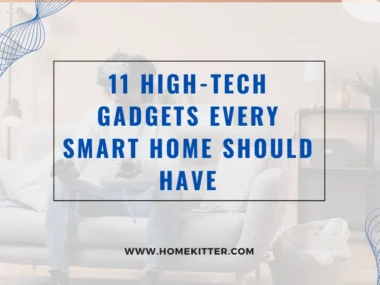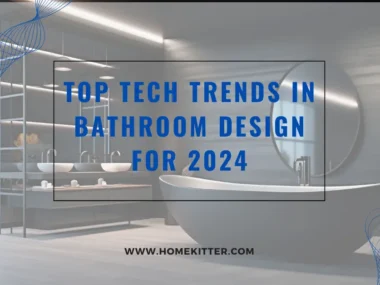Table of Contents
From smart air conditioners to smart lighting to smart thermostats, smart technology has revolutionized home devices, thereby increasing efficiency and convenience in the home.
Smart air purifiers are another fantastic technological advancement that makes life easier and healthier for homeowners. With a smart air purifier, you can trust the air in your home to remain clean at all times.
Without wasting much time, let’s dive into the topic proper – Smart Air Purifiers: All You Need to Know.
What is a Smart Air Purifier?
Smart air purifiers are smart devices that combine the function of cleaning indoor air with great technological features, making them way more functional than a standard air purifier.
Air purifiers in general help to eradicate small particles of dust, smoke, pet dander, pollen, and other pollutants that can harm you from your home. They use a fan to pull in air from the room, clean it up by trapping any particles that may be floating around, and then recirculate pure air. This process may be different for each type of air purifier.
One of the things that differentiates each one of them is the type of filter that they use. Typically, an air purifier with a High-efficiency particulate air (HEPA) filter is considered the best, as it does a better job than any other type.
Most smart air purifiers tend to combine this filter type with other ones, making them more efficient than the standard ones. You will however have to change the filters in these devices (air purifiers in general) if you want them to perform effectively.
Furthermore, unlike a standard air purifier that can only be operated using the buttons found on them, or at best, a remote control, smart air purifiers can be controlled using a smartphone or even voice commands, when connected to a virtual assistant. This improves their efficiency, as it allows the user to control the device from anywhere.
They also have WiFi connectivity, voice control features, and so on.
Features of Smart Air Purifiers
1. They can be controlled using a smartphone: These smart devices can be controlled using a smartphone application that lets you set schedules, turn them on and off, adjust settings, and so on, from anywhere.
2. Voice control: If connected to a virtual assistant like Alexa, you can operate a smart air purifier using voice commands.
3. Filter replacement notifications: There is a need to replace the filters in your air purifiers if you want them to perform well, and one of the features of a smart air purifier is that it monitors the usage and lifespan of filters, and sends you reminders on your phone to replace when it is time to do so.
4. Wi-Fi Connectivity: These smart devices connect to your home’s Wi-Fi network, making it possible for them to work with other smart devices in your home.
5. Smart scheduling: You can set smart air purifiers to turn on and off or adjust their operation at certain times. This ensures that the air in your home remains clean at all times without the need for you to operate them (the smart air purifiers) at all.
Benefits of Air Purifiers
1. They reduce your exposure to pollution: Using air purifiers in your home can help limit how exposed you are to pollution, thereby regulating your blood pressure.
Generally, long-term filtration has been known to improve cardiovascular health. Therefore, a well-functioning air purifier can help to ensure your well-being and keep you healthy.
2. Reduction of pathogens in the air: Another benefit of air purifiers is that they clean the air in your home, ridding it of pathogens that can cause infection eventually.
3. Elimination of bad smells: Certain air purifiers are capable of eliminating terrible smells by absorbing them while filtering the air in your home.
4. It helps you sleep better: Certain bacteria and fungi that can initiate inconveniences such as coughing, watery eyes, sore throat, and so on, are eliminated by air purifiers, thereby improving your sleep.
5. Annihilates harmful asbestos particles: Certain old houses expose their residents to asbestos dust which can trigger symptoms such as loss of appetite, difficulty swallowing, and so on. Air purifiers can help annihilate these harmful particles.
6. Stunts mould growth: High-efficiency particulate air (HEPA) filters, which are usually found in quality air purifiers help to control the growth of mould in the home.
DIY Home Garden Automation: Smart Solutions for Green Thumbs
Benefits of Smart Air Purifiers
Standard air purifiers pose numerous benefits to homeowners’ health but smart air purifiers take their (air purifiers’) functionality a step further. Some of the additional advantages provided by smart air purifiers are:
1. Individualized insights and recommendations: One of the benefits of smart air purifiers is that they give the users individualized insights and recommendations based on elaborate air quality data, allowing them to make smart decisions regarding the interior of their home.
2. Remote control and monitoring: Unlike standard air purifiers, these smart devices can be operated and monitored from any location, using a smartphone application. This way, you can decide to turn on your air purifiers before leaving work for home, so the air there (air) gets cleaned before you arrive.
3. Less money is spent on energy: These smart devices are capable of doing their best work while allowing you to keep an eye on how much energy they are consuming. You can always regulate their energy consumption, thereby cutting back on the amount of money spent on electricity.
4. Integration with smart home hubs: You can connect these smart devices with smart home hubs such as Amazon Alexa or Google Assistant, so you can control them using voice commands.
5. Automation feature: Another key benefit of smart air purifiers is that you can automate them so they turn on at a particular time, and off at a particular time. This helps you manage your indoor air quality better.
Types of Air Purifiers
While HEPA (High-Efficiency Particulate Air) filters remain the most common type of filters found in most standard and smart air purifiers, there are also some other types. It is worth noting that some smart air purifiers feature a combination of two or three types of filters. That said, here are the different types of air purifiers:
1. HEPA Filters: Air purifiers that have HEPA filters are so efficient that they are capable of capturing the tiniest of pollutants, especially the ones that can’t be seen by human eyes. This helps to guarantee the user’s safety by removing these pollutants while keeping the indoor air quality perfect.
2. Ultraviolet Light Air Purifiers: This type is unique in the sense that it uses UV rays to eliminate any germ that might be present in the air, thereby keeping it (the air) clean.
3. Activated Carbon: Although air purifiers with activated carbon filters aren’t capable of removing viruses and bacteria the way purifiers with HEPA filters do, they do a great job trapping unpleasant odours.
4. Ozone Generators: Air purifiers with ozone generators are rarely used in private residences because it renders the room inhabitable for the next 24 hours. This is because being exposed to the emission causes chest pain, coughing, and shortness of breath. However, these air purifiers help to annihilate bad odours.
5. Portable: This air purifier is differently designed to enable mobility so you can use it in different locations.
Factors to Consider When Choosing An Air Purifier
1. Filter type: There are different types of filters including High-Efficiency Particulate Air (HEPA) filters, activated carbon, and so on.
The best air purifier to go for when selecting an air purifier is one with a true HEPA filter. To protect your health, avoid choosing air purifiers that use that use UV or ionization.
2. Noise level: Various air purifiers have different noise levels, depending on how you set it. To maintain a peaceful and quiet space while simultaneously cleaning your indoor air, ensure to pick ones that will still work efficiently, even when you set it to a lower noise level.
3. Clean air delivery rate (CADR): This represents how quickly an air purifier can clean the air of a certain room size, by removing dust, smoke, and pollen particles.
It is usually measured in cubic feet per minute (CFM). For instance, an air purifier with 400 CFM will clean the air in a 400-square-foot room a lot quicker than one with 300 CFM.
4. Ozone Emission: Air purifiers that produce ozone gas while cleaning air should be avoided so you don’t do irreparable damage to your health.
5. Maintenance: Another factor to consider when choosing an air purifier is the cost of maintaining it, i.e. how often you would have to change its filter. Certain filters like HEPA need to be changed once in three months if you want your air purifier to do its best job.
If you choose an air purifier with a combination of filters, you will spend a lot more managing it.
6. Smart features: If you can afford it, try choosing an air purifier with smart features. Smart air purifiers can be automated to turn on and off at certain times, and you can also operate them remotely via a smartphone application.
Also, they provide you with useful information such as when to change their filters, what the air quality in your room is, and so on.
The point is:
Smart air purifiers clean the air in your home more effectively compared to the standard ones, thanks to smart features that offer absolute convenience and improve functionality.






